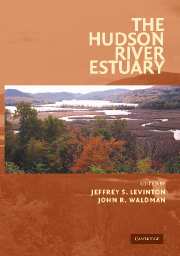Book contents
- Frontmatter
- Contents
- Preface
- List of Contributors
- The Hudson River Estuary
- 1 The Hudson River Estuary: Executive Summary
- GEOLOGICAL, PHYSICAL, AND CHEMICAL SETTING OF THE HUDSON
- 2 The Hudson River Valley: Geological History, Landforms, and Resources
- 3 The Physical Oceanography Processes in the Hudson River Estuary
- 4 Sedimentary Processes in the Hudson River Estuary
- 5 Benthic Habitat Mapping in the Hudson River Estuary
- 6 Reconstructing Sediment Chronologies in the Hudson River Estuary
- 7 Major Ion Geochemistry and Drinking Water Supply Issues in the Hudson River Basin
- PRIMARY PRODUCTION, MICROBIAL DYNAMICS, AND NUTRIENT DYNAMICS OF THE HUDSON
- HUDSON RIVER COMMUNITIES, FOOD WEBS, AND FISHERIES
- CONTAMINANTS AND MANAGEMENT ISSUES OF THE HUDSON RIVER ESTUARY
- Index
- Plate section
- References
6 - Reconstructing Sediment Chronologies in the Hudson River Estuary
Published online by Cambridge University Press: 06 January 2010
- Frontmatter
- Contents
- Preface
- List of Contributors
- The Hudson River Estuary
- 1 The Hudson River Estuary: Executive Summary
- GEOLOGICAL, PHYSICAL, AND CHEMICAL SETTING OF THE HUDSON
- 2 The Hudson River Valley: Geological History, Landforms, and Resources
- 3 The Physical Oceanography Processes in the Hudson River Estuary
- 4 Sedimentary Processes in the Hudson River Estuary
- 5 Benthic Habitat Mapping in the Hudson River Estuary
- 6 Reconstructing Sediment Chronologies in the Hudson River Estuary
- 7 Major Ion Geochemistry and Drinking Water Supply Issues in the Hudson River Basin
- PRIMARY PRODUCTION, MICROBIAL DYNAMICS, AND NUTRIENT DYNAMICS OF THE HUDSON
- HUDSON RIVER COMMUNITIES, FOOD WEBS, AND FISHERIES
- CONTAMINANTS AND MANAGEMENT ISSUES OF THE HUDSON RIVER ESTUARY
- Index
- Plate section
- References
Summary
abstract The sediments of the Hudson River Estuary record chronologies of the history of sediment and contaminant accumulation. The distribution of natural and anthropogenic radionuclides in the sediments provides a means of deciphering the sediment chronology because the rates of supply and decay of the radionuclides are known. Radionuclides that are useful in this context include naturally occurring 234Th (Thorium), 7Be (Beryllium), and 210Pb (Lead), as well as anthropogenic 137Cs (Cesium), input from atmospheric testing of atomic weapons and in association with the use of nuclear power. Sediment accumulation in the Hudson, as in many other estuaries, is controlled by a dynamic equilibrium among the processes responsible for transporting sediment. This equilibrium can shift seasonally, moderated by river discharge, tidal mixing, and other natural forces, or be shifted by human activities such as dredging or pier construction. Sediment chronologies of Hudson cores determined from natural radionuclides show that coves, marginal areas, and the inner harbor are areas of enhanced accumulation. Short-term storage of sediment is evident off Manhattan following the spring freshet, but these high rates of sediment accumulation are not sustained on longer, decadal time scales. Sediment chronologies also help to interpret the sediment record of particle-associated contaminants in the context of temporal changes of contaminant input and accumulation. To fully realize this application, it is necessary to build a long-term database of cores for which chronologies have been determined. Key stations should be re-cored over time to document trends in contaminant accumulation.
- Type
- Chapter
- Information
- The Hudson River Estuary , pp. 65 - 78Publisher: Cambridge University PressPrint publication year: 2006
References
- 1
- Cited by



